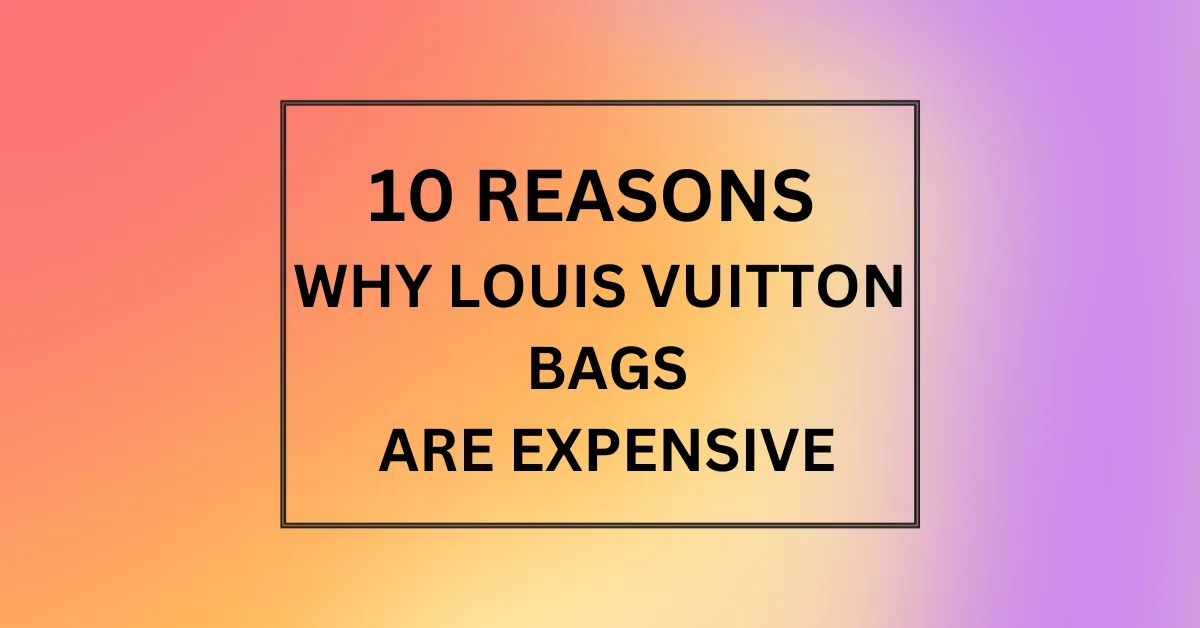Louis Vuitton bags are expensive because of the brand's longstanding prestige, the meticulous craftsmanship required, and the high-end materials sourced to construct these exclusive and iconic luxury pieces.
Louis Vuitton bags have been coveted status symbols for over a century. With their iconic monogram design and impeccable craftsmanship, LV bags ooze luxury. But they also come with eye-watering price tags, leaving many people wondering – why exactly are Louis Vuitton bags so expensive?
There are several reasons these French fashion pieces cost a pretty penny. Let’s explore the top 10 factors that contribute to the hefty Louis Vuitton price tag.
Top 10 Reasons Why Are Louis Vuitton Bags So Expensive
1. Brand Heritage and Reputation
As one of the most recognizable luxury brands in the world, Louis Vuitton has built enormous value in its name and reputation over the years. Founded in 1854, it is one of the oldest fashion houses. LV’s longstanding heritage of quality and prestige allows the brand to demand higher prices. Consumers are not just paying for the product but the status symbol of owning an iconic LV piece.
2. Handcrafted Quality and Attention to Detail
Meticulous craftsmanship goes into every Louis Vuitton design. Experienced artisans hand make each bag taking extreme care with even the smallest details. The raw materials selected are of the highest quality. Durable leathers, canvas, and hardware ensure the bags last for many years. Such premium quality and attention to detail require more time, effort, and rare skills – all of which increase costs.
3. Exclusivity
From limited edition capsules to elite invite-only experiences, Louis Vuitton cultivates exclusivity. Keeping inventory levels slightly lower than demand helps make the bags more desirable. Louis Vuitton items are still handmade in France using a time-intensive process that cannot mass produce huge quantities. This air of exclusivity allows the brand to command higher prices for its bags.
4. Design Innovation
Louis Vuitton is committed to innovation, pioneering new bag designs, materials, and manufacturing techniques. Recent examples include bags made from graphene and basketball leather. Such innovation requires significant investment in research and technology. The costs of pushing boundaries through fresh ideas and new manufacturing methods get incorporated into the final prices of the bags.
5. Raw Materials Sourcing
From the highest quality leathers to natural exotic skins and precious metals, Louis Vuitton sources sumptuous raw materials to construct its bags. Procuring limited quantities of these rare, top-notch materials is challenging. But LV goes the extra mile to obtain superior textiles. From crocodile skin to silk satin, the unparalleled quality of raw materials accounts for a portion of the pricing.
6. Vertically Integrated Supply Chain
Unlike other brands that outsource manufacturing, Louis Vuitton maintains a vertically integrated supply chain. This gives them tight control over everything from raw materials sourcing to the training of expert artisans. Keeping production in-house provides quality assurance but increases operational costs. LV commits to its made in France heritage, which requires paying higher local wages rather than shifting labor overseas.
7. High-End Retail Spaces
Step inside any Louis Vuitton boutique and you’ll find an opulent interior with top-notch customer service. LV invests heavily in creating an immersive luxury retail environment. Stores feature expensive finishes and abundant sales staff. Renting and outfitting LV’s global network of retail spaces in the world’s most desirable locations costs big money – again reflected in product pricing.
8. Powerful Brand Associations
Collaborations with prominent figures like Supreme and major celebrities provide a halo effect. Coveted artists like Jeff Koons and big-name ambassadors link the LV name with prestige. Louis Vuitton also pays top dollar to secure prime advertising real estate in locations like Times Square. These powerful and expensive brand associations reinforce the exclusivity and elite status, justifying higher prices.
9. Research and Development Costs
Behind the scenes, Louis Vuitton invests significantly in R&D. At innovation hubs like ENSCI in Paris, LV pores over new materials, conducts prototyping, and develops fresh concepts. To push the boundaries of design and stay ahead of trends, LV commits ample resources to experimentation and discovery. These R&D endeavors come at a price reflected in Louis Vuitton bag tags.
10. Healthy Profit Margins
As a luxury brand, Louis Vuitton enjoys strong pricing power. Consumers expect to pay a premium for LV bags. The brand sets prices at a level to deliver healthy profit margins for shareholders. That means there is a built-in markup providing desirable revenue and profits. As a successful business, LV does not apologize for cashing in on its sought-after name and products. Robust margins keep the brand chugging along.
Is Louis Vuitton bags a good brand?
Yes, Louis Vuitton is one of the most prestigious and iconic luxury fashion houses, known for excellent craftsmanship and enduring, high-quality leather goods.
Are Louis Vuitton bags good?
Louis Vuitton bags are exceptional – made from fine materials like leather and canvas, using meticulous methods that ensure durability, style, and luxury.
Are Louis Vuitton bags worth the price?
For many buyers, the superior craftsmanship, brand reputation, and sheer exclusivity make Louis Vuitton bags worth their high price tags as aspirational and timeless investments.
Where to buy Louis Vuitton bags?
Louis Vuitton bags can be purchased directly through LV boutiques, the LV website, select department stores, and pre-owned through reputable consignment sellers if seeking discontinued or rare styles.

